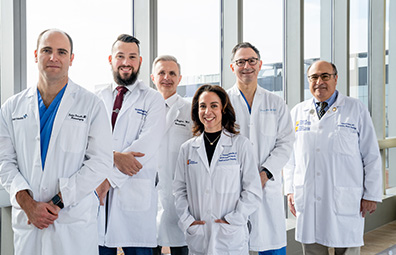Glioblastoma Multiforme and Anaplastic Astrocytomas
These high-grade gliomas originate from the supportive tissue of the brain (glial cells). There are several types of these tumors, including astrocytomas. These tumors are classified into four grades that reflect their degree of severity. The highest grade is the most malignant (cancerous) and fast-growing. They can arise at any age, but are more common in adult patients.

Meet Our Brain Tumor Care Team
Meet the specialists at the Gerald J. Glasser Brain Tumor Center who are experts in treating glioblastoma multiforme and other high-grade gliomas.
Meet the TeamTypes
Astrocytomas are a form of glioma named after astrocytes, the star-shaped glial cells which support and regulate electrical impulses in the brain. They are widely distributed throughout the brain and spinal cord. Anaplastic Astrocytomas are high-grade (grades III and IV), malignant gliomas that are some of the most common primary brain tumors in adults.
Glioblastoma Multiforme (GBM) are the most aggressive type of astrocytoma and highest-grade (grade IV) glioma. The most common primary brain tumor in adults, they usually arise sporadically but can also develop from lower grade gliomas. These tumors are invasive and commonly spread throughout the brain.
Symptoms
Glioblastomas and anaplastic astrocytomas may become large before they begin to cause noticeable symptoms, which can include:
- Headaches
- Nausea
- Seizures
- Memory loss
- Vision loss
- Language impairments
- Changes in personality
- Cognitive impairments
- Weakness or numbness in the arms or legs
Diagnosis
High-grade gliomas are diagnosed through a neurological examination followed by a computed tomography (CT) or magnetic resonance imaging (MRI) scan of the brain. MRI scans are usually performed with contrast dye to help identify the tumor’s size, location and type.
An exact diagnosis can only be confirmed following a stereotactic biopsy or surgical removal of the tumor. Tissue analysis by a neuropathologist defines the diagnosis and genetic profile of the tumor.
Treatment
Treatment for a high-grade glioma typically starts with surgery to remove the tumor. We use the latest techniques to make craniotomy (surgical opening of the skull) as safe and effective as possible. These techniques include:
- Stereotactic volumetric techniques help the surgeon achieve a near-total removal of the tumor.
- Depending on the location of the tumor, the neurosurgeon may employ advanced techniques to safely remove a tumor even in the parts of the brain that handle speech, vision and movement:
Alternatively, laser interstitial thermal therapy (LITT) may be used as a minimally invasive surgical alternative to open craniotomy. Or, a biopsy could be performed in patients with medical conditions that don't allow for surgery – or when there are concerns about the location of the tumor.
Additional treatment is needed after surgery because glioblastoma multiforme and anaplastic astrocytoma cells typically grow into the surrounding brain tissue. The next steps are determined by the exact tumor type and grade, a molecular analysis of the tumor and the extent of your removal surgery. Insights from our genetic and molecular analysis of your tumor can help predict how effective chemotherapy and other treatments will be.
Members of our multidisciplinary tumor board will work together to recommend the best personalized and targeted treatment options incorporating the latest molecular diagnostics, treatment protocols and participation in national clinical trials.
Follow-up treatments could include:
Our team will closely monitor you and personalize your follow-up care. Our patient navigator will also connect you with our support group and other resources.
Research
New therapies to fight gliomas – such as immunotherapy, vaccine therapy, gene therapy and new chemotherapies – are being researched and gene expression profiling is being used to evaluate the efficacy of targeted molecular drugs.
In addition, molecular markers are increasingly being used to support the diagnosis of gliomas. For example, somebody's genetic makeup can predict their response to certain chemotherapies or drugs.
For Newly-Diagnosed Patients
Immunotherapy and Radiation Therapy for Newly Diagnosed Glioblastoma
For Newly-Diagnosed Patients
Adding SurVaxM Vaccine Therapy to Standard of Care Chemotherapy
For Patients With Recurrent Glioblastoma
Immunotherapy for Recurrent Glioblastoma
This phase II study examines immunotherapy drugs ipilimumab and nivolumab in patients with glioblastoma that has recurred and carries a high number of mutations. These immunotherapy medications with monoclonal antibodies may help the body's immune system attack cancerous cells and may interfere with tumor cells’ ability to grow and spread.
For Patients With Recurrent Glioblastoma